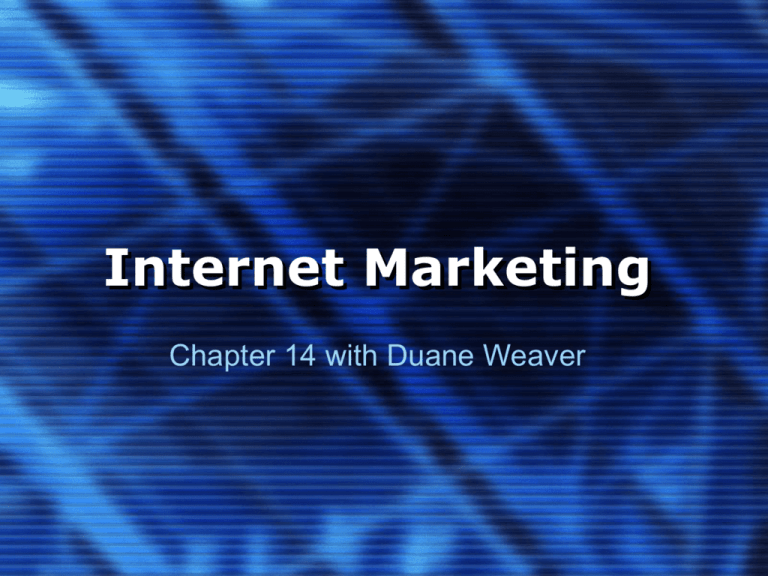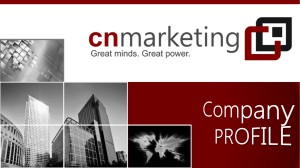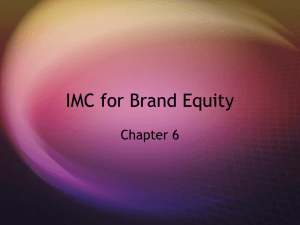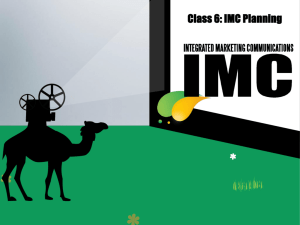Internet Marketing
advertisement

Internet Marketing Chapter 14 with Duane Weaver Internet Uses • Most common products researched online and bought offline: – Cars, computers, travel, electronics, books appliances, music, sporting goods and clothing. • 25% of all business-business purchases are done online • 54% of email users have responded to e-mail advertisements (2004) • Internet retail is 2.5% of all retail sales Impact of Internet on Marketing • The following 3 functions can cost up to 30% of COGS, expectations are that these costs can be reduced to 10-20% via e-commerce. – Sales – Marketing – Distribution Systems • Albeit, operating costs can be substantially lowered, the business must have: – Infrastructure (perhaps vested technology as a fixed cost or leased as an added operating expense (can void net gain)) – Focus and design of company (bricks and mortar vs. virtual?) • Design of Website must be conducive to the IMC plan and established to the benefits of the target audience: – Excellent for psychographic segmentation – Multiple portals tailored to each segment (vs. one face for all) – Use flashy where needed (affective buyers) and avoid it where frivolous (cognitive buyers) – Integrate cookies and path traveled information with purchase habits – Requires constant modification to be on top of consumer needs – Must have multiple Trust Cues Success with E-Commerce • E-Commerce: selling of goods or services online. • Three Incentives must exist for customers to buy online: – Financial: currently first time consumers require financial incentive (price reduction) in addition to trust cues. – Convenience: ability to order anytime from anywhere without having to visit a store. Delivered to your door. – Value Added: needed to induce long term repeat business such as: • Personalization (Lands End, Amazon.com) • Permission based marketing based on profiles • Reduced information search (find it all in once place – Insurance companies, E-bay) Business-Business E-Commerce • Works well for repeat purchasing of low cost items with strong brand recognition. • Can help to speed time to market, as well as reduce inventory and transaction costs. • Increase in online brokerage services for business to business…facilitating exchange of goods. (e.g.: PaperExchange.com) • Websites can serve as alternate media to drive visits to bricks and mortar • Nature of goods needs to be conducive to world-wide shipping when considering world wide web store front for international business • Must be designed to handle such an enterprise (structure and function, marketing, aligned to meet expectations) IMC and the Internet • In addition to using the Internet as part of the IMC plan for communications and marketing… – Fundamental to integrated the entire company from IT through to human resources, production and shipping. – The ability to meet the demands of online marketing is as important to survivability as having web presence. – Technology does not solve business problems…it expedites those that already exist! What once was broke and took attention once a week…will still be broken, however, it may take attention once an hour. Fix the business processes, align the companies resources, plan, build and then engage with a vengeance! • Brand Spiraling: using traditional media to drive customers to the online website to enhance brand recognition. • Halo Effect: offline brand recognition induces online willingness to try new products and services from the same brand on the net. Discussion Questions • Please get into groups of 3-5 and discuss the following three questions, be prepared to share some of your answers with the class: – P. 459-460 (blue book) and P. 431 (white book) Questions: • 1. (Only in blue book): What age group is most likely to use the Internet? Which is the least? Does this have implications for IMC programs (explain)? • 5. (Both books): Name and describe the three main incentives used to attract shoppers to e-commerce Web sites. • 6.(Both books): What is cyberbait? How must it be used over time to maintain it as an effective marketing tactic? Thank You











